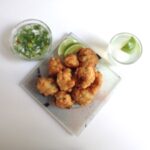 Strong drink may be needed to get through the next couple of weeks, so here’s a rum cocktail from the French Antilles and crispy cod fritters to go with it. The cocktail, ti punch, is based on rhum agricole, a clear rum distilled from cane sugar juice with a flavor remarkably different from other rums on the market. Add some lime juice and raw sugar, and your mood will definitely improve. The fritters are fun to make and come with a spicy salsa.
Strong drink may be needed to get through the next couple of weeks, so here’s a rum cocktail from the French Antilles and crispy cod fritters to go with it. The cocktail, ti punch, is based on rhum agricole, a clear rum distilled from cane sugar juice with a flavor remarkably different from other rums on the market. Add some lime juice and raw sugar, and your mood will definitely improve. The fritters are fun to make and come with a spicy salsa.
Ti punch / Ti punch
Acras de morue / Spicy cod fritters
Sauce chien / French Caribbean salsa
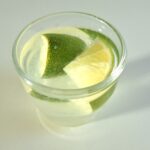 Let’s start with the cocktail. Ti punch is said to have been invented in 1848 on the tiny island of Marie Galante to celebrate the abolition of slavery. The island, which is temptingly described as having white sand beaches, lush greenery and sweeping views, is part of Guadeloupe, one of France’s two Caribbean island départements — i.e. they’re not territories, like Puerto Rico in the case of the States, but actual ‘states’ like Hawaii.
Let’s start with the cocktail. Ti punch is said to have been invented in 1848 on the tiny island of Marie Galante to celebrate the abolition of slavery. The island, which is temptingly described as having white sand beaches, lush greenery and sweeping views, is part of Guadeloupe, one of France’s two Caribbean island départements — i.e. they’re not territories, like Puerto Rico in the case of the States, but actual ‘states’ like Hawaii.
The other such island is Martinique, which produces the only rhum agricole to have been granted the AOC quality-control label (Appellation d’Origine Côntrolée). And here’s the thing about rhum agricole. It’s absolutely delicious. And while it may be harder to find outside of France, it’s available elsewhere via online shopping sites (see recipe for details).
If settling in for a long night of watching election returns, or for any other reason, you can mix up a pitcher of ti punch to go the distance. But this cocktail is traditionally mixed in the glass, one by one, often by the guests themselves (with as much rum as they care to add). Ice is not traditional — oddly, the drink is served at room temperature in the steamy tropics — but no one says you can’t add it if you prefer the drink chilled, as I do.
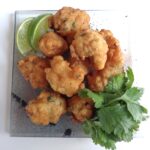 Now for the fritters. Acras de morue are traditionally made from salt cod, which must be desalted. But fresh cod may be substituted with no discernable difference in flavor. You mince the cod in a food processor, add shallot, parsley, allspice and hot pepper, and mix with a simple batter before frying in hot oil. As you drop each spoonful of the mixture into the oil, little balls magically take form. You can serve the fritters straight out of the pot — any kids who may be around will demand it — or set them aside for reheating later.
Now for the fritters. Acras de morue are traditionally made from salt cod, which must be desalted. But fresh cod may be substituted with no discernable difference in flavor. You mince the cod in a food processor, add shallot, parsley, allspice and hot pepper, and mix with a simple batter before frying in hot oil. As you drop each spoonful of the mixture into the oil, little balls magically take form. You can serve the fritters straight out of the pot — any kids who may be around will demand it — or set them aside for reheating later.
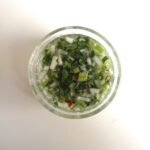 The fritters marry well with sauce chien, which translates as ‘dog sauce’ but has nothing to do with dogs. This French Caribbean salsa is in fact named for a steel knife used locally with the brand name Couteau Chien®. Sauce chien differs from Latin American salsas because it does not include tomatoes. It’s made of fresh herbs, onion, scallion, garlic, hot pepper, oil and water — you can make it as spicy as you like by varying the amount of hot pepper.
The fritters marry well with sauce chien, which translates as ‘dog sauce’ but has nothing to do with dogs. This French Caribbean salsa is in fact named for a steel knife used locally with the brand name Couteau Chien®. Sauce chien differs from Latin American salsas because it does not include tomatoes. It’s made of fresh herbs, onion, scallion, garlic, hot pepper, oil and water — you can make it as spicy as you like by varying the amount of hot pepper.
For the record, the Couteau Chien® is manufactured by the knife maker Thiers-Issard in Auvergne, in the heart of France, but is sold primarily in the Antilles. According to the broadcaster France Info, the knives are so popular there that the market was flooded at one point with counterfeits from China, identifiable because the dog on the fake knives immodestly displayed their private parts.
Meanwhile here in Paris, where we are now under a 9 p.m. curfew, the autumn nights are stretching not just longer but lonelier. In a country where the dinner hour begins around 8, friends can’t come be invited because they wouldn’t make it home in time. And fines for violating the curfew are steep: 135 euros ($160) for a first violation, 200 euros for a second and 3,750 euros plus six months in jail for a third.
Parisians are getting creative to ward off solitude. One popular solution is le cocktail dinatoire — an early evening cocktail party with significant hors d’oeuvres. Such events can include up to six people, the limit decreed by the government for any gathering. Another solution, and I claim credit for this one, is the sleepover dinner, aka le pyjama party. I’m trying this out tonight for the first time, with one guest only. We’ll see.
With restrictions tightening around the globe, we need all the help we can get to make it through this depressing season. But take it from me — wherever you may be, a few rounds of ti punch with spicy cod fritters on the side are guaranteed to cheer the atmosphere.
Happy cooking.

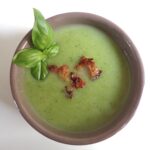 Some days you just need a nice bowl of soup. And the French take on broccoli soup is just right for easing body and soul given the climate of this turbulent autumn (and I’m not talking about the weather). The basic recipe is ultrasimple. Broccoli is simmered with potato, leek, and garlic, then puréed to smoothness. Add a dash of lemon juice, stir in some cream and top with croutons. That’s the French way — but there are many variations…
Some days you just need a nice bowl of soup. And the French take on broccoli soup is just right for easing body and soul given the climate of this turbulent autumn (and I’m not talking about the weather). The basic recipe is ultrasimple. Broccoli is simmered with potato, leek, and garlic, then puréed to smoothness. Add a dash of lemon juice, stir in some cream and top with croutons. That’s the French way — but there are many variations… You can go Italian, stirring in some olive oil and topping each bowl with grated parmesan. For a Spanish flavor, add chorizo chips. Or — one of my favorites — skip the cream and instead add finely grated ginger and a swirl of coconut milk. All of these versions are healthy and tasty, and two are vegan — with croutons (no cream), and with ginger and coconut milk.
You can go Italian, stirring in some olive oil and topping each bowl with grated parmesan. For a Spanish flavor, add chorizo chips. Or — one of my favorites — skip the cream and instead add finely grated ginger and a swirl of coconut milk. All of these versions are healthy and tasty, and two are vegan — with croutons (no cream), and with ginger and coconut milk. One day a colleague of mine at the International Herald Tribune arrived with a bagful of quinces and handed it over. ‘Do you know what to do with these?’ he asked. Thus began my adventure in cooking with quince, a fruit I had rarely encountered before. Every autumn I try my hand at one dish or another. This year, I made chicken with quinces, a dish richly spiced with cumin, cinnamon, coriander and saffron, and sweetened with honey.
One day a colleague of mine at the International Herald Tribune arrived with a bagful of quinces and handed it over. ‘Do you know what to do with these?’ he asked. Thus began my adventure in cooking with quince, a fruit I had rarely encountered before. Every autumn I try my hand at one dish or another. This year, I made chicken with quinces, a dish richly spiced with cumin, cinnamon, coriander and saffron, and sweetened with honey. If you’ve never encountered a quince, it’s an exquisitely perfumed yellow fruit that looks like a cross between an apple and a pear. In France, it is mainly used to make pâte de coings, a sturdy jelly that is served in sugar-coated squares. In Spain, this firm jelly is known as membrillo and is served with Manchego cheese. Other countries, like Iran and Azerbaijan, use quinces in various savory dishes, often paired with lamb or poultry.
If you’ve never encountered a quince, it’s an exquisitely perfumed yellow fruit that looks like a cross between an apple and a pear. In France, it is mainly used to make pâte de coings, a sturdy jelly that is served in sugar-coated squares. In Spain, this firm jelly is known as membrillo and is served with Manchego cheese. Other countries, like Iran and Azerbaijan, use quinces in various savory dishes, often paired with lamb or poultry.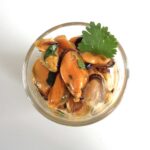 Mussels with garlic, hot pepper, olive oil and fresh herbs, served in small glasses at cocktail hour, is a specialty of the charming Mediterranean port of Sète. This is local cuisine at its finest — le piste de moules, as it’s known, can be found at the many bars lining the canals of this Venice-like town, and in the homes of its residents, but practically nowhere else in France. I have a friend who lives there, and he was kind enough to share the recipe.
Mussels with garlic, hot pepper, olive oil and fresh herbs, served in small glasses at cocktail hour, is a specialty of the charming Mediterranean port of Sète. This is local cuisine at its finest — le piste de moules, as it’s known, can be found at the many bars lining the canals of this Venice-like town, and in the homes of its residents, but practically nowhere else in France. I have a friend who lives there, and he was kind enough to share the recipe. I discovered le piste de moules on a visit to Sète a few years back during the height of summer, when the town is crowded with tourists and the beautiful white beaches are packed with lounge chairs, umbrellas and happy swimmers. I went back a couple of times, but decided not to go to the Mediterranean shore this year because of the virus. Nonetheless, I had a hankering for the dish and made it twice over the summer — in July in Normandy, and in August in Paris. Traditionally the fresh herb used is parsley, but I innovated, using basil once and cilantro the other time. Fine.
I discovered le piste de moules on a visit to Sète a few years back during the height of summer, when the town is crowded with tourists and the beautiful white beaches are packed with lounge chairs, umbrellas and happy swimmers. I went back a couple of times, but decided not to go to the Mediterranean shore this year because of the virus. Nonetheless, I had a hankering for the dish and made it twice over the summer — in July in Normandy, and in August in Paris. Traditionally the fresh herb used is parsley, but I innovated, using basil once and cilantro the other time. Fine. When staying with friends in Provence this summer, I was served a mixed-grain salad that knocked my socks off. The star of this salad was petit épeautre, or einkorn wheat, a rustic grain with a nutty flavor that is grown locally and has become popular among foodies throughout France. It married delightfully with the other ingredients — quinoa, lentils, chopped herbs, shallots, ginger and an Asian-inspired sauce of sesame oil, soy and lemon juice.
When staying with friends in Provence this summer, I was served a mixed-grain salad that knocked my socks off. The star of this salad was petit épeautre, or einkorn wheat, a rustic grain with a nutty flavor that is grown locally and has become popular among foodies throughout France. It married delightfully with the other ingredients — quinoa, lentils, chopped herbs, shallots, ginger and an Asian-inspired sauce of sesame oil, soy and lemon juice.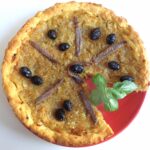 This onion-anchovy-olive tart from the south of France looks remarkably like pizza. (And it’s name, pissaladière, would seem to be related to pizza, too. More on that later.) I had the good fortune on a recent trip to Provence to be treated twice to pissaladière, one homemade and the other from a bakery. When I got back to Paris last week, I decided to try my hand at this classic dish, which hails from the Mediterranean city of Nice.
This onion-anchovy-olive tart from the south of France looks remarkably like pizza. (And it’s name, pissaladière, would seem to be related to pizza, too. More on that later.) I had the good fortune on a recent trip to Provence to be treated twice to pissaladière, one homemade and the other from a bakery. When I got back to Paris last week, I decided to try my hand at this classic dish, which hails from the Mediterranean city of Nice. Swiss chard makes a beautiful gratin that is as packed with nutrients as it is with flavor. I made the gratin this week on Bastille Day, on which I will say more later. My first question, as I was preparing the dish, was: Why did it take me so long to discover Swiss chard? Not until I moved to France did I encounter this wonderful vegetable. My second question was: Since there’s nothing Swiss about it, how did Swiss chard get its name?
Swiss chard makes a beautiful gratin that is as packed with nutrients as it is with flavor. I made the gratin this week on Bastille Day, on which I will say more later. My first question, as I was preparing the dish, was: Why did it take me so long to discover Swiss chard? Not until I moved to France did I encounter this wonderful vegetable. My second question was: Since there’s nothing Swiss about it, how did Swiss chard get its name?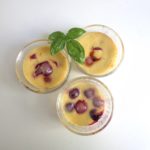 It’s cherry season in France, so when guests came the other night I served mini cherry cheesecakes made with goat cheese. A surprise and a delight! A surprise because I invented the recipe. This is a rare event. Most of the dishes on this site are French classics that I reinterpret in the everyday chef style — simple and modern. And a delight because the goat cheese lends a delicate edge to a dessert that’s both light and deeply flavorful.
It’s cherry season in France, so when guests came the other night I served mini cherry cheesecakes made with goat cheese. A surprise and a delight! A surprise because I invented the recipe. This is a rare event. Most of the dishes on this site are French classics that I reinterpret in the everyday chef style — simple and modern. And a delight because the goat cheese lends a delicate edge to a dessert that’s both light and deeply flavorful. Tender veal served cold with tarragon mayonnaise and seasonal veggies — for example, asparagus, green beans and fresh peas in early summer — makes a delightful supper that can be prepared in advance for easy serving. Or you can serve the roast hot, surrounded by veggies and drizzled with succulent sauce. Either way, break open a bottle of wine, slice up some crusty bread, bring the roast to the table and prepare for applause.
Tender veal served cold with tarragon mayonnaise and seasonal veggies — for example, asparagus, green beans and fresh peas in early summer — makes a delightful supper that can be prepared in advance for easy serving. Or you can serve the roast hot, surrounded by veggies and drizzled with succulent sauce. Either way, break open a bottle of wine, slice up some crusty bread, bring the roast to the table and prepare for applause. Whether to serve the meat cold or hot is a matter of taste and the weather. When serving it hot, you skip the mayo and instead use the roasting juices to make a flavorful sauce that is drizzled over the veggies and the meat.
Whether to serve the meat cold or hot is a matter of taste and the weather. When serving it hot, you skip the mayo and instead use the roasting juices to make a flavorful sauce that is drizzled over the veggies and the meat.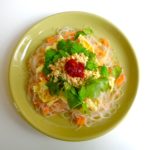 One day many years ago a friend took me to a tiny Vietnamese restaurant here in Paris where we were served the best Vietnamese food I’ve ever had outside Vietnam. Our starter was a tangy salad of glass noodles, carrots, shredded omelet, cilantro, crushed peanuts and hot sauce — and it knocked my socks off. I’ve gone back many times for that salad. And today, thanks to Madame Duong, who owns the place, I’d like to share the recipe.
One day many years ago a friend took me to a tiny Vietnamese restaurant here in Paris where we were served the best Vietnamese food I’ve ever had outside Vietnam. Our starter was a tangy salad of glass noodles, carrots, shredded omelet, cilantro, crushed peanuts and hot sauce — and it knocked my socks off. I’ve gone back many times for that salad. And today, thanks to Madame Duong, who owns the place, I’d like to share the recipe.

